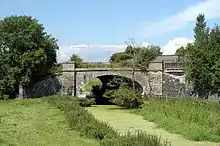Ulster Railway
The Ulster Railway was a railway company operating in Ulster, Ireland. The company was incorporated in 1836 and merged with two other railway companies in 1876 to form the Great Northern Railway (Ireland).
| Industry | railway |
|---|---|
| Fate | merged |
| Successor | Great Northern Railway (Ireland) |
| Founded | 1836 |
| Defunct | 1876 |
| Headquarters | , |
Area served | County Antrim, County Armagh, County Down, County Monaghan |
History
The Ulster Railway was authorised by an Act of the UK Parliament in 1836[1] and construction began in March 1837.[2]
The first 8 miles (13 kilometres) of line, between Belfast Great Victoria Street and Lisburn, were completed in August 1839 at a cost of £107,000.[2] The line was extended in stages, opening to Lurgan in 1841,[3] Portadown in 1842,[4] and Armagh in 1848.[4]

In 1836 a Railway Commission recommended that railways in Ireland be built to 6 ft 2 in (1,880 mm) broad gauge.[2] The Ulster Railway complied with this recommendation but the Dublin and Drogheda Railway (D&D) did not. In order for Dublin and Belfast to be linked without a break-of-gauge, in 1846 the UK Parliament passed an Act adopting a compromise gauge of 5 ft 3 in (1,600 mm) for Ireland, to which the Ulster Railway's track was then re-laid.[2]
Extension of the Ulster Railway resumed, reaching Monaghan in 1858,[4] Smithborough in 1862[4] and Clones on the Dundalk and Enniskillen Railway, later the Irish North Western Railway (INW), in 1863.[5]
The Dublin and Belfast Junction Railway (D&BJct) between Drogheda and Portadown was completed in 1853.[6] This connected the D&D with the Ulster Railway, thus completing the main line between Dublin and Belfast.[6]
The Ulster Railway operated three lines that remained in the ownership of separate companies: the Portadown, Dungannon and Omagh Junction Railway (PD&O), the Banbridge, Lisburn and Belfast Railway (BLBR) and the Dublin and Antrim Junction Railway (D&AJR).[7] The PD&O reached Dungannon in 1858[4] and Omagh in 1861,[8] and the contractor, William Dargan, sold the Ulster a 999-year lease on it in 1860.[9][7] The BLBR opened between Knockmore Junction and Banbridge in 1863,[3] and the D&AJR opened between Knockmore Junction and Antrim in 1871.[3][10]
In 1876 the Ulster Railway merged with the INW and the Northern Railway of Ireland (formed by a merger of the D&D and the D&BJct the previous year) to form the Great Northern Railway (Ireland).
Preserved stock

One example of Ulster Railway rolling stock has survived. The body of No. 33, built as a family saloon in 1862 and withdrawn in the 1920s having passed into GNR hands, is preserved at the Downpatrick and County Down Railway. It is currently on display in the Carriage Gallery, and it is hoped that it will be fully restored in the future.
References
- McCutcheon 1969, p. 15.
- McCutcheon 1969, p. 43.
- Hajducki, 1974, map 9
- Hajducki, 1974, map 8
- Hajducki, 1974, map 14
- McCutcheon 1969, p. 40.
- Hajducki 1974, p. xiii.
- Hajducki, 1974, map 7
- FitzGerald 1995, p. 1.
- Hajducki, 1974, map 5
Sources and further reading
- FitzGerald, J.D. (1995). The Derry Road. Colourpoint Transport. Gortrush: Colourpoint Press. p. 1. ISBN 1-898392-09-9.
- Hajducki, S. Maxwell (1974). A Railway Atlas of Ireland. Newton Abbott: David & Charles. ISBN 0-7153-5167-2.
- McCutcheon, Alan (1969). Ireland. Railway History in Pictures. 1. Newton Abbott: David & Charles. ISBN 0-7153-4651-2.
- Patterson, E.M. (1986) [1962]. Great Northern Railway of Ireland. Oakwood Library of Railway History. Lingfield: Oakwood Press. ISBN 0-85361-343-5.
- Whishaw, Francis (1842). The Railways of Great Britain and Ireland Practically Described and Illustrated (2nd ed.). London: John Weale. pp. 430–437. OCLC 833076248.
External links
- 1843 Timetable for Belfast and Portadown, from Bradshaw's Railway Monthly